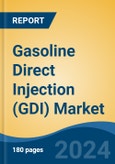Electronic Controls Units is the fastest growing segment, North America is the largest market globally
Speak directly to the analyst to clarify any post sales queries you may have.
10% Free customizationThis report comes with 10% free customization, enabling you to add data that meets your specific business needs.
Key Market Drivers
The global Gasoline Direct Injection GDI market is significantly influenced by stringent global automotive emission regulations. Regulatory bodies worldwide are continuously tightening standards to mitigate environmental impact from vehicle exhaust, compelling manufacturers to adopt more efficient powertrain technologies. For instance, according to Regulation (EU) 2024/1257, published in May 2024, Euro 7 emissions requirements will become mandatory for new types of M1 and N1 category vehicles from November 29, 2026, necessitating advanced combustion systems like GDI to meet reduced limits for pollutants.Key Market Challenges
A significant challenge impeding the expansion of the Global Gasoline Direct Injection (GDI) Market is the higher manufacturing cost associated with GDI systems compared to conventional fuel injection alternatives. This increased complexity and expense directly translates to elevated production costs for automotive manufacturers. Consequently, this factor can restrict the widespread adoption of GDI technology, particularly within cost-sensitive automotive segments.Key Market Trends
The increased integration with hybrid powertrains represents a crucial development for GDI technology. As automotive manufacturers prioritize electrified solutions, GDI engines are frequently paired with electric motors in hybrid configurations to optimize fuel efficiency and reduce emissions across various driving conditions. This synergy allows GDI to leverage its precise fuel delivery in conjunction with electric power for superior overall system performance. According to the U.S. Energy Information Administration, in the first quarter of 2025, approximately 22% of light-duty vehicles sold in the United States were hybrid, battery electric, or plug-in hybrid vehicles, marking an increase from 18% in the first quarter of 2024, with hybrid electric vehicles continuing to gain market share.Key Market Players Profiled:
- Autocam Corp. Inc.
- Carter Fuel Systems LLC
- Clean Air Power
- DENSO Corp.
- Ford Motor Co.
- GP Performance GmbH
- Hyundai Motor Co.
- Infineon Technologies AG
- Liebherr International AG
- Marelli Holdings Co. Ltd.
Report Scope:
In this report, the Global Gasoline Direct Injection (GDI) Market has been segmented into the following categories:By Component:
- Electronic Controls Units
- Fuel Injectors
- Fuel Pumps
- Sensors
By Support Technology:
- Gasoline Turbocharger
- GPF
By Vehicle Type:
- Passenger Vehicle
- Commercial Vehicle
By Region:
- North America
- Europe
- Asia Pacific
- South America
- Middle East & Africa
Competitive Landscape
Company Profiles: Detailed analysis of the major companies present in the Global Gasoline Direct Injection (GDI) Market.Available Customizations:
With the given market data, the publisher offers customizations according to a company's specific needs. The following customization options are available for the report:- Detailed analysis and profiling of additional market players (up to five).
This product will be delivered within 1-3 business days.
Table of Contents
Companies Mentioned
- Autocam Corp. Inc.
- Carter Fuel Systems LLC
- Clean Air Power
- DENSO Corp.
- Ford Motor Co.
- GP Performance GmbH
- Hyundai Motor Co.
- Infineon Technologies AG
- Liebherr International AG
- Marelli Holdings Co. Ltd.
Table Information
| Report Attribute | Details |
|---|---|
| No. of Pages | 180 |
| Published | November 2025 |
| Forecast Period | 2024 - 2030 |
| Estimated Market Value ( USD | $ 7.15 Billion |
| Forecasted Market Value ( USD | $ 11 Billion |
| Compound Annual Growth Rate | 7.4% |
| Regions Covered | Global |
| No. of Companies Mentioned | 10 |









